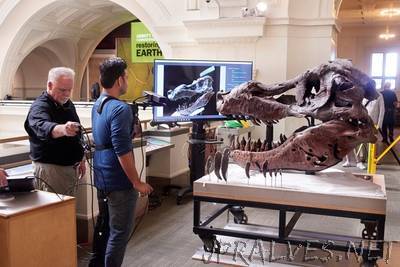
“Last year, a team of forensic dentists got authorization to perform a 3-D scan of the prized Tyrannosaurus rex skull at the Field Museum of Natural History in Chicago, in an effort to try to explain some strange holes in the jawbone. Upon discovering that their high-resolution dental scanners couldn’t handle a jaw as big as a tyrannosaur’s, they contacted the Camera Culture group at MIT’s Media Lab, which had recently made headlines with a prototype system for producing high-resolution 3-D scans. The prototype wasn’t ready for a job that big, however, so Camera Culture researchers used $150 in hardware and some free software to rig up a system that has since produced a 3-D scan of the entire five-foot-long T. rex skull, which a team of researchers — including dentists, anthropologists, veterinarians, and paleontologists — is using to analyze the holes. The Media Lab researchers report their results in the latest issue of the journal PLOS One. “A lot of people will be able to start using this,” says Anshuman Das, a research scientist at the Camera Culture group and first author on the paper. “That’s the message I want to send out to people who would generally be cut off from using technology — for example, paleontologists or museums that are on a very tight budget. There are so many other fields that could benefit from this.” Das is joined on the paper by Ramesh Raskar, a professor of media arts and science at MIT, who directs the Camera Culture group, and by Denise Murmann and Kenneth Cohrn, the forensic dentists who launched the project. The system uses a Microsoft Kinect, a depth-sensing camera designed for video gaming. The Kinect’s built-in software produces a “point cloud,” a 3-D map of points in a visual scene from which short bursts of infrared light have been reflected back to a sensor. Free software called MeshLab analyzes the point cloud and infers the shape of the surfaces that produced it. A high-end commercial 3-D scanner costs tens of thousands of dollars and has a depth resolution of about 50 to 100 micrometers. The Kinect’s resolution is only about 500 micrometers, but it costs roughly $100. And 500 micrometers appears to be good enough to shed some light on the question of the mysterious holes in the jaw of the T. rex skull.”
